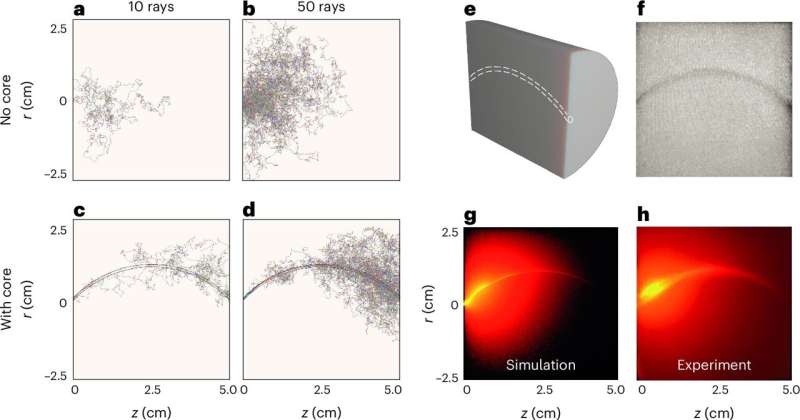
November 1, 2024 by University of Glasgow
Collected at: https://phys.org/news/2024-11-cloud-method-waveguiding-mechanism-ways.html
Scientists have taken inspiration from the way sunlight passes through clouds to discover an entirely new way of controlling and guiding light.
The breakthrough research, led by physicists from the University of Glasgow, allows light waves to be guided around curved paths tunneled through opaque materials that would normally scatter them in all directions.
The findings could find applications in future generations of medical imaging technology, providing new ways for doctors to look inside the human body.
The research could also be adapted to guide heat instead of light, opening up new applications in thermal management for computing systems, and to confine particles like neutrons instead of light waves, which could find use in nuclear technologies.
The “waveguiding” effect the team have discovered is analogous to fiber optic cable, which carries light through its core by using a process called total internal reflection. In fiber optics, the core is surrounded by a cladding material with a lower refractive index, which keeps the light bouncing along the core’s length, allowing it to travel long distances with minimal loss.
The researchers’ new waveguiding mechanism instead relies on a very different physical process. Instead, light is transported through a solid core of weakly scattering material, which is in turn encased in a material which scatters much more strongly.
The contrast between the scattering properties of the materials confines the light to the core and enables it to be guided with unexpectedly high precision.
The research, which is showcased in a new paper published in Nature Physics, was sparked by lab discussions about clouds, says the paper’s corresponding author, Professor Daniele Faccio.
Professor Faccio, who leads the University of Glasgow’s Extreme Light research group, said, “Tall cumulus clouds are often bright white at their tallest point and dark gray at their lowest because sunlight is scattered through the countless water droplets which are contained in the cloud’s interior.
“The light decays exponentially as it scatters through the cloud, making the lower part darker, and is reflected at the top, which makes it white.
“We started to wonder whether it might be possible to harness that scattering effect in a controlled way, and to use it to create a path to guide light through scattering materials.”
The team used a 3D printer to make highly scattering opaque white resin structures with a low-scattering core, and began to experiment with guiding light through the structures.
They found it was possible to transmit more than 100 times more light through the low-scattering core than in structures without it. They showcased the phenomenon with both straight and curved structures which both display the effect.
The team also developed a comprehensive mathematical model to explain the physical processes of diffusion which underpin their results. Remarkably, the model is very similar to equations which explain the transport of heat through solid materials. Because of this crossover, the researchers expect that their new technique could have wider use beyond light.
Professor Faccio, of the University’s School of Physics & Astronomy, added, “It’s remarkable that even in well-established fields like optics, there’s always room for fundamental new discoveries. When we began thinking about clouds, we weren’t necessarily expecting to discover an entirely new method of waveguiding, but that’s where our experiments have led us.
“We’re still learning new tricks about light, in this case by a process that we were surprised to discover has more in common with our understanding of the way heat travels than light.
“That means that we can expect to use this technique to find new ways to see inside opaque biological tissue using light, but also that we can apply it to guide more than just photons. We could create new ways to carry heat through systems which need to be cooled, like data center computers, or to transport particles like neutrons, which could open up new applications for nuclear power plants, for example.”
Dr. Kevin Mitchell, a member of the Extreme Light research group and lead author of the paper, said, “The strength of this paper comes from the comprehensive approach we took to exploring the possibility of an entirely new approach to guiding light.
“We started with a key question, demonstrated it experimentally, then proved it mathematically with real rigor. Now that we’ve built a strong practical and theoretical foundation, we’ll continue to explore how we can find new ways to use this in the future.”
Professor Ewan Wright from the University of Arizona also contributed to the research.
More information: Kevin J. Mitchell et al, Energy transport in diffusive waveguides, Nature Physics (2024). DOI: 10.1038/s41567-024-02665-z
Journal information: Nature Physics

Leave a Reply